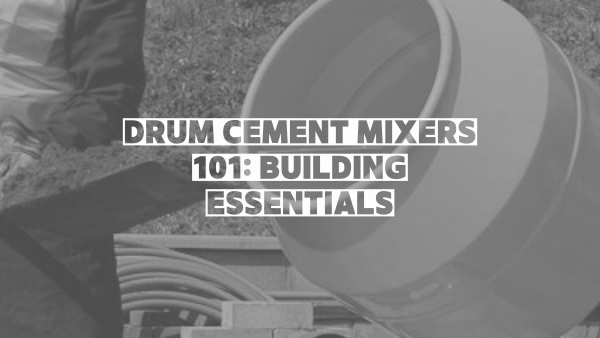Drum Cement Mixers 101 – Building Essentials
Whether you are looking to lay a brand new patio, build an extension or fill in some footings. One essential piece of equipment you are going to require is a cement mixer. Cement mixers have been a key component in construction for over 100 years, with the earliest designs being horse-drawn in 1904. In today’s market, there is far much more choice, size, designs and jargon to work through to find the right one for your project. That’s why in today’s article, we will help you understand the ins and outs of a drum cement mixer, its components, and the benefits between the designs.
What is a drum cement mixer?
All cement mixers are designed to combine various components to form a product to be used for construction. Most commonly for the mix cement, aggregate and water to make concrete or mortar. Drum cement mixers come in several shapes and sizes to accommodate the size and scale of different projects. The use of this piece of construction equipment will effectively speed up your production process and reduces the overall amount of manual labour.. Without a cement mixer, the only way to combine your raw materials is by hand.
Components of a cement mixer
Each design of a drum cement mixer is slightly different, however, they are generally made up of the same basic elements. A drum, mixing paddles, motor and method extraction. Some mixers are mounted on stands, where others sit on frames. Some designs can be disassembled where others are fixed. See diagrams below.
Types of mixer drum mixer
There are many types of cement mixers, but the most popular style to come across is a drum mixer. More so, tilting drum mixers. These are designed to discharge your combined compounds when tilted forward. Its speedy discharge process is commonly used on building sites worldwide by a fast passed workforces. Tilted drum cement mixers are available in a range of different capacities or ‘volumes’ to cater for different size projects. Mixing efficiently is very important when it comes to time-sensitive projects, so choosing the right mixer is very important.
What size of drum cement mixer suits best?
One-off use
If you are thinking about doing a one-off project and require a mixer, a 90L drum machine should be the ideal tool for the job. Unlike smaller mixers available on the market, the 90L can make a full wheelbarrow of concrete or mortar at a time. These smaller designs of cement mixers are powered by either electricity or fuel, depending on your requirements. With the ability to dismantle their components, they can also be transported with ease. Tilted drum mixers are mounted on a portable stand, allowing operators to pour directly into a wheelbarrow when ready.
Professional use
If you find yourself mixing concrete on building sites most days, then a heavy-duty machine with a larger mixing volume would be far more beneficial. These machines, unlike their smaller designs, are built with larger capacities and for all-day work. Starting from 170L upwards, these fuel power machines can distribute larger quantities at one time. Petrol or diesel-powered cement mixers are ideal for all building sites that do not have access to mains electricity or a generator. We would recommend that a fuel-powered cement mixer should be transported on a trailer or towed directly behind a vehicle, depending on the design of the mixer.
What is Mixing volume?
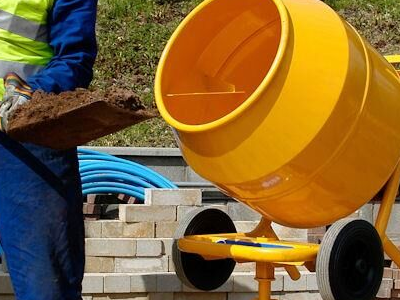
When choosing the right drum cement mixer for your project, it is important to understand a machine’s mixing volume. The two most common terms you will come across when looking at hiring a cement mixer are drum volume and mixing volume, of which there are differences between to two. The mixing capacity of a drum mixer is approx. 80% of the volume of the drum. For example, 170L capacity will produce around 137 litres of cement. (2 Wheelbarrow loads).
When mixing concrete or builders mix, it is easy to be carried away trying to overload the machine to increase your output. Avoid doing this at all costs. If overloaded, the mixer can cannot bind all your components together. This will have a detrimental effect on the quality of the output you produce. Not only may it look different, which is important with brickwork, but it may also be far weaker and workable to use.
Mixing ratios
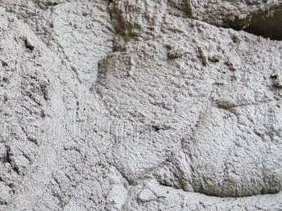
Mixing ratios are the recipes for your required mix. Please note, every concrete will react differently within a mix depending on the brand and quality you use. Nevertheless, you can use the following mix ratios to get you started. Do not rush the mixing process, as it is important for all components to bind correctly with each other.
Concrete Mix Ratio
4 parts aggregate, 2 parts sand, 1 part cement. 0.5 part water
Builders Mix Ratio
5 parts sand, 1 part cement, 0.5 part water & mortar plasticiser mixed
Before mixing any of the elements together, it is best advised to add a small amount of water or water/plasticiser, (mix dependant) to your drum before commencing. This will prevent any of the components from sticking to the inside of the drum during operation.
The amount of water you use mixing can be extremely variable. This could be because of the temperature, humidity, and sunlight available outside. Remember, though, that the more water you add, the weaker the cement’s cured tensile strength and adhesive strength will be. It’s best to always add more water or water/plasticiser (builders mix) as you go. If you find that your mixture is too wet, add a little more sand and cement, but remember the ratios set out in this article.
Benefits of an electric mixer

Electric mixers have several benefits compared to petrol mixers. First, they are extremely simple and easy to transport. Generally, small enough to be transported in the back of a standard hatchback car. As well as being simple and easy to step up. The most common designs of electric mixer you will find is 110V or 240V single phase, however, some designs will require 3 phase (340V) to operate. Note that to operate some mixers, you may require a transformer.
Site transformers offer more safety in the event of an accident occurring. Please note: Not all tool hire companies include the cost of a transformer with a cement mixer hire. Therefore, it is worth checking with your provider before hiring any equipment.
Another massive benefit of having an electric mixer is that they are so simple and easy to maintain and require little to no maintenance. This is providing that they are cleaned after every use.
Benefits of a Petrol/Diesel Drum Cement Mixer
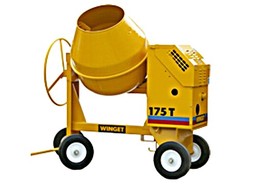
Petrol/diesel mixers are, in some ways, undeniably the stronger candidate of the two. Its ability to work anywhere without access to power makes it a far more desirable option. Besides this, with more power, comes larger outputs and production speed. Some fuelled powered mixers can be towed behind your vehicle and be manoeuvred into a working position instead. It is quite easy to see why building sites favour this type of machine.
How much does it cost to hire a cement mixer?
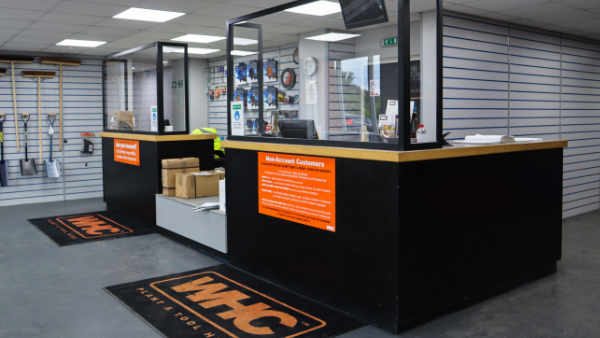
Cement mixers weekly hire cost depends on the type and quality of the machine. Small 90L 1/2 bag tilted drum cement mixers will vary in price between £22.00-£46.00 per week. Larger fuel-powered machines range from £46.00 to over £100 per week. All prices are excluding VAT.
Where to hire the right site mixer for your project?
For over 20 years, WHC Hire has been supplying the trade and bidding DIYers with the highest quality construction and building tools available on the market. With regular investments into the quality of our machinery and tools, we are able to provide customers with the tools to get the job done. With depots in Tewkesbury, Worcester and Chipping Norton in the Cotswolds, our services are never too far away. See what building equipment we have to offer, or contact us on 01684377977 today for more information.

